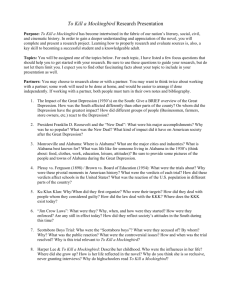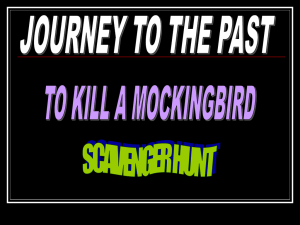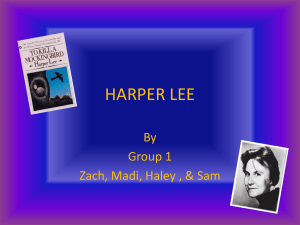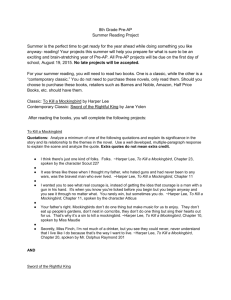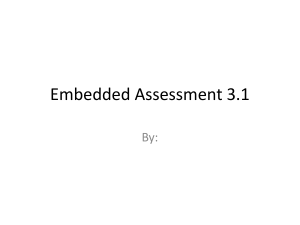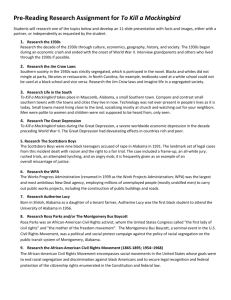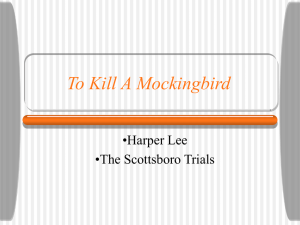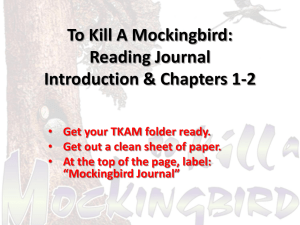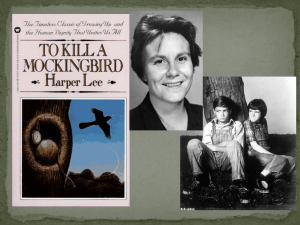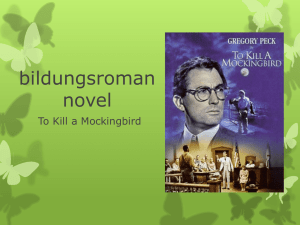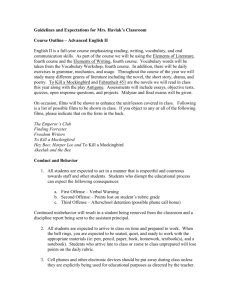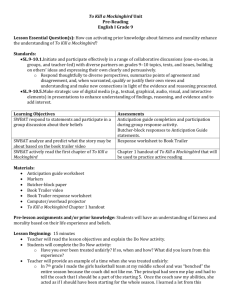Mockingbird Embedded Assessment Presentation
advertisement
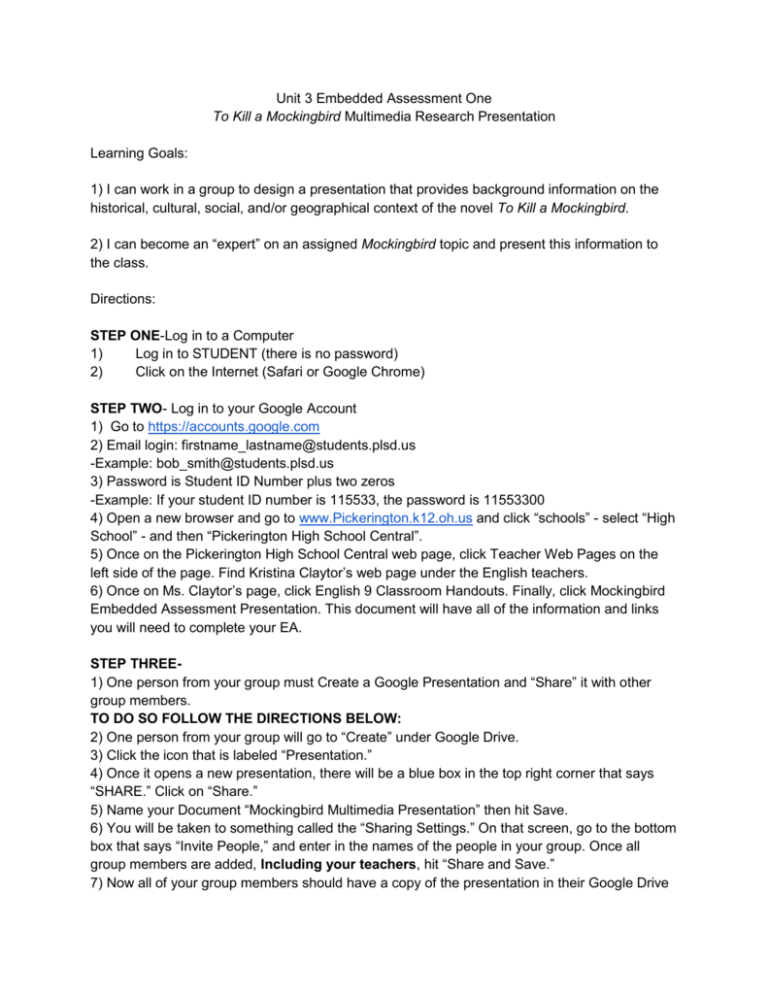
Unit 3 Embedded Assessment One To Kill a Mockingbird Multimedia Research Presentation Learning Goals: 1) I can work in a group to design a presentation that provides background information on the historical, cultural, social, and/or geographical context of the novel To Kill a Mockingbird. 2) I can become an “expert” on an assigned Mockingbird topic and present this information to the class. Directions: STEP ONE-Log in to a Computer 1) Log in to STUDENT (there is no password) 2) Click on the Internet (Safari or Google Chrome) STEP TWO- Log in to your Google Account 1) Go to https://accounts.google.com 2) Email login: firstname_lastname@students.plsd.us -Example: bob_smith@students.plsd.us 3) Password is Student ID Number plus two zeros -Example: If your student ID number is 115533, the password is 11553300 4) Open a new browser and go to www.Pickerington.k12.oh.us and click “schools” - select “High School” - and then “Pickerington High School Central”. 5) Once on the Pickerington High School Central web page, click Teacher Web Pages on the left side of the page. Find Kristina Claytor’s web page under the English teachers. 6) Once on Ms. Claytor’s page, click English 9 Classroom Handouts. Finally, click Mockingbird Embedded Assessment Presentation. This document will have all of the information and links you will need to complete your EA. STEP THREE1) One person from your group must Create a Google Presentation and “Share” it with other group members. TO DO SO FOLLOW THE DIRECTIONS BELOW: 2) One person from your group will go to “Create” under Google Drive. 3) Click the icon that is labeled “Presentation.” 4) Once it opens a new presentation, there will be a blue box in the top right corner that says “SHARE.” Click on “Share.” 5) Name your Document “Mockingbird Multimedia Presentation” then hit Save. 6) You will be taken to something called the “Sharing Settings.” On that screen, go to the bottom box that says “Invite People,” and enter in the names of the people in your group. Once all group members are added, Including your teachers, hit “Share and Save.” 7) Now all of your group members should have a copy of the presentation in their Google Drive Jigsaw Activity -Each group will be assigned one area of expertise to research and create a presentation. -The requirements for the presentation are as follows: 1) Title slide that has all group member’s names on it and the title of the presentation. 2) AT LEAST 10 additional slides/pages of content including ONE GRAPHIC/PICTURE on each slide as well as 3-5 bullet points or pieces of information on each slide. 3) You must include at least one “multimedia” component (a video, a song, a speech/excerpt from a speech etc.). 4) During your presentation, all research questions provided must be answered/covered. 4) A final slide(s) that act as a “Works Cited” slide that includes an MLA Citations on the websites you used for your research. You will use http://www.easybib.com and copy and paste the website title in there to get your information for the Works Cited Slide. 5) Cutting and pasting words from the Internet is NOT permitted. You must interpret research and paraphrase/put in your own words. If it is a direct quote, you must put quotation marks around it and tell where you got it or who said it etc. (provide parenthetical citation) 6) You must use MORE than one website. Feel free to use the ones provided, but you can branch out and find your own information. AVOID SPARKNOTES, CLIFF NOTES, and SHMOOP. 7) You will be graded on completeness, accuracy, clarity, and creativity as well as the components on the Springboard Embedded Assessment rubric. Group One- About the Author/Harper Lee and reading To Kill A Mockingbird: Websites to use: About Harper Lee-Use for Questions #1-7 http://www.kirjasto.sci.fi/harperle.htm http://www.biography.com/people/harper-lee-9377021 About Reading To Kill A Mockingbird- Use for Questions #8-10 http://www.ala.org/ala/issuesadvocacy/banned/frequentlychallenged/21stcenturychallenged/index.cfm http://www.ala.org/ala/issuesadvocacy/banned/frequentlychallenged/challengedbydecade/index.cfm (For the answer, look at the index to the left - there are two decades to choose from!) Research Questions to be Covered/Answered in Presentation: About Harper Lee1. When and where was Harper Lee born? What was her family like? 2. Who was her childhood best friend? 3. What did she study in college? Did she participate in any extracurricular activities? Why might this be important to consider while reading To Kill A Mockingbird? 4. How did her decision to move to New York make To Kill A Mockingbird a reality? 5. What year was To Kill A Mockingbird published? When was it adapted to screen? 6. Was Harper Lee honored in any way following the publication of To Kill A Mockingbird? 7. Harper Lee's real life influenced many of the characters and events in To Kill A Mockingbird. Given what have you learned about her life (including personality traits, friends, family, experiences) make a prediction about what kinds of issues might surface in the book. Do you think that your knowledge about Harper Lee will influence your reading of the book? Should it influence your reading of the book? Why or why not? About To Kill a Mockingbird 8. Over the past nine years, how frequently are books challenged? 9. What reasons are frequently given for challenging books? 10. Look at the list of classics that have been challenged. Where does To Kill a Mockingbird fall and what reasons are given for it being challenged? Group Two- The Scottsboro Boys/Trials Website to use: http://law2.umkc.edu/faculty/projects/FTrials/scottsboro/scottsb.htm Research Questions to be Covered/Answered in Presentation: 1. Who were the Scottsboro Boys? How did they get into so much trouble? 2. Where and when did the Scottsboro Boys' original trial take place? How do you think this affected the outcome of their trial? 3. What does the NAACP acronym stand for? Why did the NAACP decide not to help the Scottsboro Boys? 4. The Communist Party came to the aid of the Scottsboro Boys. How did the South perceive the Communist Party, and how was it similar to the perception of blacks? What was the Communist Party's hidden agenda in providing aid to the Scottsboro Boys? 5. The Scottsboro Boys were not provided with adequate defense lawyers. Please list at least 3 ways in which the defense lawyers were inadequate. 6. Describe the trials. Were they fair or unfair? Please include at least 3 supporting facts to back up your description. 7. Were the Scottsboro Boys ever pardoned of their convictions? 8. The Scottsboro Boys' trial took place during the childhood of To Kill A Mockingbird's author, Harper Lee.. Make a prediction about how this trial might be an important impetus for the book. Group 3- Jim Crow Laws Websites to use: https://en.wikipedia.org/wiki/Jim_Crow_laws http://www.ferris.edu/jimcrow/what.htm Research Questions to be Covered/Answered in Presentation: 1. Where did the term "Jim Crow" come from? How is the origin of this term offensive? List 3 ways. 2. How did the term "Jim Crow" become synonymous with the segregation laws in the South? 3. What ended Reconstruction in the South, and what effect did that have on southern blacks? 4. Legally, African-Americans had the right to vote. How was their right to suffrage compromised? Please list 3 ways whites made it nearly impossible for blacks to vote. 5. How did the Plessy v. Ferguson case (1896) uphold Jim Crow laws? What effect did this case have on the lives (transportation, education, social implications, etc) of southern blacks? 6. Give at least 3 examples of different Jim Crow laws. Explain the laws in your own words. Group Four- The Great Depression Websites to use: http://en.wikipedia.org/wiki/Great_Depression-Use for Questions #1-4 http://www.english.illinois.edu/maps/depression/overview.htm -Use for Question #5 http://us.history.wisc.edu/hist102/lectures/lecture18.html -Use for Questions #6-7 http://www.livinghistoryfarm.org/farminginthe30s/life_20.html -Use for Question #8 Research Questions to be Covered/Answered in Presentation: 1. What is "Black Tuesday" and why does it mark the beginning of the Great Depression? 2. Many people believe that WWII marked the end of the Great Depression. How did the war affect the economy? 3. What president was inaugurated in 1933? What were some of the changes made by this administration? 4. What was the New Deal? How did the New Deal affect American citizens? 5. How many people were unemployed in 1933? What did they do? 6. Social Problems: What social problems occurred in the USA as a result of the depression? 7. Images of the Depression: How did the Depression affect farmers? 8. What did families and children do for fun during the Great Depression? List some different activities. Why did they do these activities instead of things like going to the movies etc.? Group 5- Growing up in the Black/White in the South during the 1930s Websites to use: Growing up Black in the 1930s- Use for Questions 1-5: http://fsd79.schoolwires.net/cms/lib/IL01001571/Centricity/Domain/262/Black%20in%201930s.pdf Growing up White in the 1930s- Use for Questions 6-11: http://intranet.oswego308.org/schools/uploads/files/3206/tkam_interview_growing_up_white.pdf Research Questions to be Covered/Answered in Presentation: 1. What were the living conditions of blacks during this time period? 2. Mrs. Barge notices a difference between the lives of black people and the lives of white people. From Mrs. Barge's account, what do you think is the most astounding difference? 3. What was school like for blacks? 4. What kind of jobs were available to black people in the South? 5. Were black people allowed to vote? 6. What do these three ladies have in common about their ancestry? How do they talk about their families? 7. What were the three ladies living conditions like? 8. What were these ladies' first experiences with black people? 9. Did these white ladies ever play with their black peers? 10. Compare the three ladies' backgrounds from "Growing up White in the 1930s." How do their backgrounds differ from Mrs. Barge's background from "Growing up Black in the 1930s"? 11. The ladies in "Growing up White in the 1930s" talk about what made a "good family" in the South. What do they say makes a "good family"?
